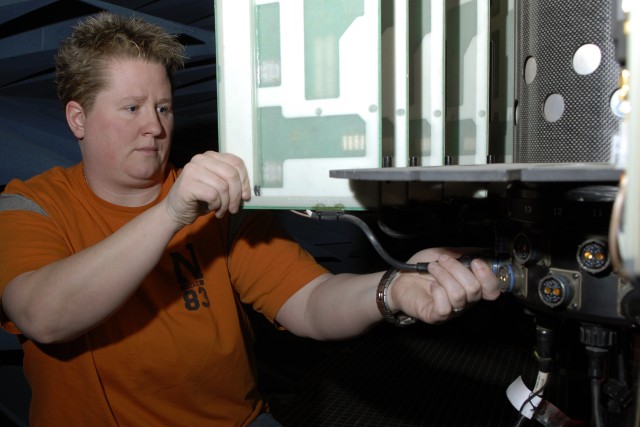TOBYHANNA ARMY DEPOT, PA. - Two key radar programs earned awards at the 2010 PA Technology Awards ceremony in Harrisburg.
The AN/TPQ-37 Firefinder Reliability, Maintainability, and Improvement (RMI) program earned first prize in the "Technology Provider of the Year" category. The Lightweight Counter Mortar Radar (LCMR) Live Fire Test Simulator (LFTS) program was among the top three finalists in the "Best Application of Technology" category.
Bob Katulka, director of Intelligence, Surveillance and Reconnaissance Directorate; and Mark Viola, chief of the C4ISR Maintenance Engineering Division, accepted the awards which were presented on Feb. 12 by officials of TECHQuest Pennsylvania at the 18th Annual Technology Gala from the Technology Council of Central PA.
According to their web site, TECHQuest Pennsylvania is an organization of "thousands of dedicated professionals focused on making and keeping Pennsylvania a leader among states and nations in the deployment of advanced technology and the infrastructures and work forces that accomplish the same."
The Firefinder AN/TPQ-37 is a long-range weapon-locating phased array radar designed in the late 1970's. Viola said that to ensure the system would remain viable, a technology insertion was instituted to simplify the system design and maintenance requirements, and eliminate common failures in the legacy AN/TPQ-37 systems.
"This upgrade is collectively known as the RMI program," he said. "We are the sole integrator for the AN/TPQ-37 radar system RMI Program. Tobyhanna played a major role in the design of much of the RMI equipment that supports the radar system."
Improvements to the radar include replacing the Travelling Wave Tube of the antenna transceiver group with 12 Power Amplifier Modules so the radar can retain its tracking range with up to three PAMs offline.
Also, the liquid cooling system is being replaced with three blowers to cool the transmitter. "Moving to an air-cooled system greatly reduces the possibility of a cooling failure in the field and eliminates parts obsolescence concerns," Viola said.
Viola noted that the RMI program will result in a considerable cost savings to the Army over its lifetime and increase availability of the radar system to the soldiers in the field.
"We're going to upgrade 60 AN/TPA-37s to the RMI configuration over the next four years," he said.
The AN/TPQ-48(V) LCMR is a state-of-the-art system that detects, locates and reports enemy indirect fire. Tobyhanna can test the radar electronically, replacing the need for testing using live fire.
"We earned the 'top three finalist' award for an improvement that adds an electronic LFTS to the mechanical LFTS ability." Viola said. "Right now the radar is tested by raising and lowering a mechanical probe while rotating the radar in the chamber. With the new electronic version, the probe will have no moving parts, making it more accurate and reliable."
Full overhaul and repair capabilities for the AN/TPQ-48 are also expected to be in place in April 2010. Viola said that this will further reduce repair turnaround time.
Tobyhanna Army Depot is the Defense Department's largest center for the repair, overhaul and fabrication of a wide variety of electronics systems and components, from tactical field radios to the ground terminals for the defense satellite communications network. Tobyhanna's missions support all branches of the Armed Forces.
About 5,600 personnel are employed at Tobyhanna, which is located in the Pocono Mountains of northeastern Pennsylvania.
Tobyhanna Army Depot is part of the U.S. Army CECOM Life Cycle Management Command. Headquartered at Fort Monmouth, N.J., the command's mission is to research, develop, acquire, field and sustain communications, command, control computer, intelligence, electronic warfare and sensors capabilities for the Armed Forces.


Social Sharing